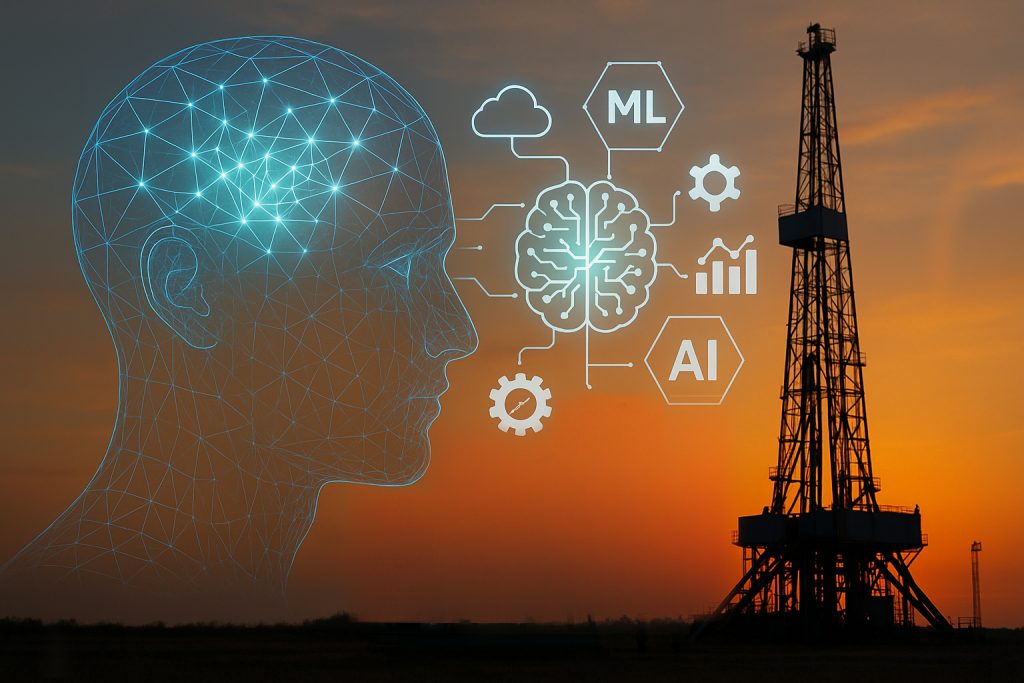This is a curated summary of a technical paper presented at the 2024 SPE Oman Petroleum & Energy Show.
In the ever-evolving landscape of the energy industry, the integration of artificial intelligence (AI) with business intelligence (BI) tools is proving to be a turning point — not only in how data is processed, but in how decisions are made. A recent case study by Petroleum Development Oman (PDO), presented at the 2024 SPE Oman Petroleum & Energy Show, sheds light on how AI-powered BI systems can revolutionize production optimization in gas-constrained oil fields.
The study is set against the backdrop of an increasingly digital and interconnected industrial ecosystem. As Industry 4.0 connected machines and systems through IoT, cloud computing, and big data, Industry 5.0 now moves toward human-AI collaboration, enabling smarter, more sustainable operations. Within this context, the paper highlights the limitations of traditional BI workflows and how AI can transform them into intelligent, adaptive decision-making tools.
At the heart of the study lies a challenge that resonates across many mature oil fields: gas management. In southern Oman, PDO operates a field where the gas-handling infrastructure has reached capacity. With no recurring well testing and limited reservoir data, operators often resort to reactive decision-making. Wells continue to produce until they reach an economic limit — a process known as “creaming” — which risks both inefficient recovery and increased environmental impact through gas flaring.
To address this, the team developed an AI-augmented BI system that combines surface-level operational data (wellhead pressure, temperature, oil and gas flow rates) with machine learning algorithms. The goal? To predict gas breakthroughs earlier, enabling proactive operational adjustments and minimizing waste.
The technical approach was intentionally pragmatic. Using Microsoft Power BI for visualization and Python-based machine learning scripts for analysis, the team trained the model on historical data from 50 wells. It then tested the system’s ability to detect early warning signs of gas increase — all without relying on complex downhole sensors or new hardware.
The result is a dashboard that doesn’t just display historical trends, but actively learns from them. Operators are alerted with visual cues (color-coded risks and predictive messages), enabling them to act before a production issue escalates. While the model’s predictive accuracy hovered around 50%, it showed stronger performance on wells with delayed gas breakthroughs — a sign that even a relatively simple AI approach can add real value to existing workflows.
What makes this effort notable isn’t just the tool itself, but its implications for the broader industry. The integration of AI into BI transforms static dashboards into dynamic decision-support systems. It reduces the burden on engineers to manually analyze incoming data, and it enables consistent monitoring across assets — something that’s often difficult to achieve at scale.
However, the authors are careful to acknowledge the limitations. The model is not yet reliable for newly drilled wells without historical data, and surface interference (e.g., changing choke sizes or equipment maintenance) can throw off predictions. There’s also the ever-present issue of data quality: garbage in, garbage out. The accuracy of AI systems depends heavily on consistent, high-quality input.
Looking forward, the paper encourages the oil and gas community to view this work as a starting point — not a finished product. Future iterations could include more complex subsurface data, additional sensor inputs, or the use of advanced algorithms such as neural networks for non-linear modeling. The end goal is not just smarter dashboards, but fully integrated, real-time surveillance platforms that support safer, cleaner, and more efficient operations.
Beyond the technical achievements, this project represents a cultural shift in how digital tools are viewed within oil and gas operations. Rather than treating AI as a distant or abstract concept, it becomes a practical enabler — one that augments human expertise rather than replaces it. In a sector where safety, efficiency, and sustainability are all under pressure, these kinds of innovations are no longer optional. They are essential.
For companies considering their next digital transformation step, this case study is an instructive example. It demonstrates that with the right combination of tools, talent, and data discipline, meaningful progress can be made — even with modest infrastructure. More importantly, it reaffirms a key truth: the future of oil and gas will not just be powered by hydrocarbons, but by intelligent systems that know how to manage them better.
Further Reading:
Access the full paper on SPE.org



We Answer Your Questions